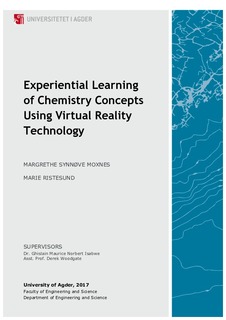| dc.contributor.author | Moxnes, Margrethe Synnøve | |
| dc.contributor.author | Ristesund, Marie | |
| dc.date.accessioned | 2017-11-24T13:26:36Z | |
| dc.date.available | 2017-11-24T13:26:36Z | |
| dc.date.issued | 2016 | |
| dc.identifier.uri | http://hdl.handle.net/11250/2468041 | |
| dc.description | Master's thesis Multimedia and Educational Technology MM500 - University of Agder 2016 | nb_NO |
| dc.description.abstract | Chemistry is a wide subject with many theoretical concepts. These theoretical concepts may be
hard to grasp without experimental work. In a school class there are often students who are
visual, auditory and kinesthetic learners who need appropriate tools for triggering engagement
and active learning. This research discusses how adding student activities and experiments
using a Virtual Reality (VR) based solution, can contribute to an enhanced learning experience
for students during chemistry class. In order to produce a usable interactive VR based solution,
this work followed the Human Centered Design process, which is an iterative design process
when creating multiple prototypes and user tests. Students interact within a VR environment in
where they perform chemical experiments and reflect on the learning activities. Participants for
the user tests were comprised of junior high-school students (13 – 16 years of age) and teachers.
The feedback and results from the user tests were considered for a final version of the VR highfidelity
prototype that is based on HTC Vive. The next tests investigated if junior high-school
students were active and engaged when performing, observing and reflecting over chemical
experiments in a virtual environment. The user tests were conducted in a controlled
environment at the University of Agder. After the students had tested the VR prototype, they
discussed with a science teacher about their experiences and observations in the VR system. The
results showed that a VR experience in a chemistry class could be a valuable asset in
combination with lectures and assignments. A VR experience can support experiential learning
and increase the students’ engagement and motivation by using VARK’s Learning Styles,
Problem-Based and Student Centered Learning approach. Consequently, the students created
concrete experience by manipulating objects and performing chemical experiments in a virtual
reality environment. They also reflected over the observations and explained the experienced
chemical reactions. Furthermore, the students expressed that they were highly motivated to
learn more about chemistry with the use of VR. Results from the tests found a high degree of the
wow-factor. Thus, the students were amazed over the VR experience and the possibilities.
Consequently, the students were distracted and sometimes did not hear or read important
information about the various substances. Future work is suggested when VR technology is
more common. Hence, the wow-factor could be decreased. There are indications that using VR in
learning chemistry could be the start of a paradigm shift.
Keywords
Virtual reality; human-centered design; chemical experiments; experiential learning | nb_NO |
| dc.language.iso | eng | nb_NO |
| dc.publisher | Universitetet i Agder ; University of Agder | nb_NO |
| dc.rights | Attribution-NonCommercial-NoDerivatives 4.0 Internasjonal | * |
| dc.rights.uri | http://creativecommons.org/licenses/by-nc-nd/4.0/deed.no | * |
| dc.subject | MM500 | nb_NO |
| dc.subject | Virtual reality | nb_NO |
| dc.subject | human-centered design | nb_NO |
| dc.subject | chemical experiments | nb_NO |
| dc.subject | experiential learning | nb_NO |
| dc.title | Experiential Learning of Chemistry Concepts Using Virtual Reality Technology | nb_NO |
| dc.type | Master thesis | nb_NO |
| dc.source.pagenumber | IX, 102 p. | nb_NO |

